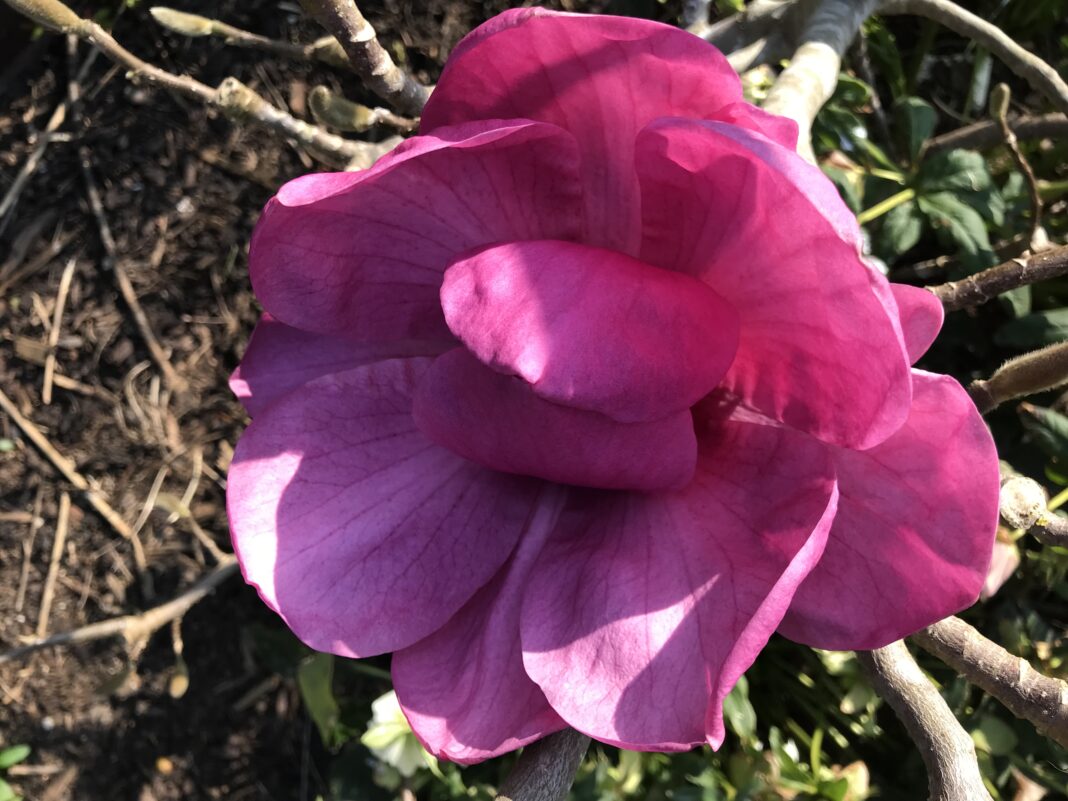April and May always feel like the busiest months in the garden. Decisions to be made:
- What has survived the winter?
- What to grow in the allotment this year and where to plant it?
- What soil to buy for planting seeds, pots and hanging baskets?
- What to order or grow as new replacement plants which will be better able to survive our dry summers and cold/wet winter?
The race is on to control weeds that seem to be growing faster than any other plant. It can be hard to stop and remember to appreciate what is in flower. But I did just that this week with a cup of tea, and I saw the fleeting wing of first a peacock butterfly, and then a tortoiseshell butterfly, just flying away from spring blooms.
For the first time in three years, the combination of rain and sun have resulted in a perfect soil – perfect for planting seeds direct in the allotment, perfect for transplanting seedlings; perfect, especially, for weeding and digging out dead and dying plants in our garden. I have made a few big mistakes in choice of some spring bulbs.

What looked like a fabulous large-flowered muscari has turned out to be a thug -leaves overwhelming other, more well-behaved, plants like pagoda lilies. Camassia have also proven too overwhelming for our flower border. I am cutting my losses and digging up and throwing out. Good workable soil also means removing the plants that didn’t survive our cold winter. As I dig them up, I try to discover if there is any life left- some salvia do have a few buds of growth at the base of the stems. We have cut them right back, re-planted in pots, and may either re-plant them if they renew themselves, or use new shoots to root new plants.
Two giant aloes are barely alive and had to go. As I dug around them, I realised they have been sitting in water-logged soil which has turned their base to mush. The French lavender is looking fine, but some of the older bushes of supposedly “tougher” lavender is woody and again has to be renewed.
And finally, our agapanthus. I despaired when they all seemed to have died off and leaves gone to mush in the cold of January. But miraculous new growth seems to be starting deep underground. I will give them all another month. Getting into the soil at this time of year tells you so much about its health, too – some areas are alive with welcome worms, and the annual mulch of compost and manure we lay down every autumn is having a good effect.
 Our little greenhouse is absolutely packed with plants, seedlings and newly planted seeds. This means daily watering, and daily checking of slugs and snails lurking under pots.
Our little greenhouse is absolutely packed with plants, seedlings and newly planted seeds. This means daily watering, and daily checking of slugs and snails lurking under pots.
I have been reading about how to be more organic with growing techniques this year in the allotment. Evidently, some combinations of plants can really hinder growth. “Allelopathic” properties of some plants release chemicals which inhibit the growth of other plants. Combinations to avoid are:
Garlic and onions with beans and peas
Mint or onions with asparagus
Brassicas with strawberries, potatoes or tomatoes.
I have read about companion planting as a method for reducing pests on crops. Our greenhouse space is so limited that I am trying to only grow flowers I think could be helpful with this method. So marigolds seem particularly useful for attracting pollinators (grow them next to tomatoes and courgettes). Evidently they can also lure aphids away from beans, and deter whitefly from greenhouses.
Other companion planting which I will try:
Mint with brassica: strong smell of mint confuse flea beetle and deter them from laying eggs
Carrots and alliums including onion garlic and leek: Carrots deters leek moth, and leeks /allium defer carrot fly
Lavender: attracts pollinators which are needed for tomato, and its scent also deters carrot and leek pests
Artemisia / wormwood: strong scent can deter aphids and black fly – plant next to bean crops. Its yellow flower attract hoverfly, lacewing and ladybird, which prey on aphids.
Salvia: strong scent will confuse pest such as flea beetle
Thyme: strong scent deters blackfly (plant next to beans and roses)
Image Credits: Abigail Cooper-Hansen .



